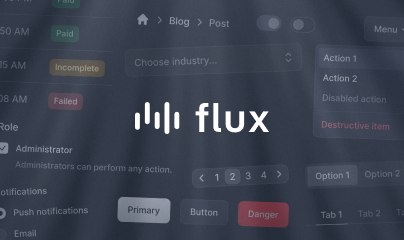Defer
The #[Defer] attribute makes a component load immediately after the initial page load is complete, preventing slow components from blocking the page render.
Basic usage
Apply the #[Defer] attribute to any component that should be deferred:
<?php // resources/views/components/⚡revenue.blade.php use Livewire\Attributes\Defer;use Livewire\Component;use App\Models\Transaction; new #[Defer] class extends Component { public $amount; public function mount() { // Slow database query... $this->amount = Transaction::monthToDate()->sum('amount'); }};?> <div> Revenue this month: {{ $amount }}</div>With #[Defer], the component initially renders as an empty <div></div>, then loads immediately after the page finishes loading—without waiting for it to enter the viewport.
Lazy vs Defer
Livewire provides two ways to delay component loading:
- Lazy loading (
#[Lazy]) - Components load when they become visible in the viewport (when the user scrolls to them) - Deferred loading (
#[Defer]) - Components load immediately after the initial page load is complete
Both prevent slow components from blocking your initial page render, but differ in when the component actually loads.
Rendering placeholders
By default, Livewire renders an empty <div></div> before the component loads. You can provide a custom placeholder using the placeholder() method:
<?php // resources/views/components/⚡revenue.blade.php use Livewire\Attributes\Defer;use Livewire\Component;use App\Models\Transaction; new #[Defer] class extends Component { public $amount; public function mount() { $this->amount = Transaction::monthToDate()->sum('amount'); } public function placeholder() { return <<<'HTML' <div> <svg><!-- Loading spinner... --></svg> </div> HTML; } };?> <div> Revenue this month: {{ $amount }}</div>Users will see the loading spinner until the component fully loads.
If your placeholder's root element is a <div>, your component must also use a <div> element.
Bundling requests
By default, deferred components load in parallel with independent network requests. To bundle multiple deferred components into a single request, use the bundle parameter:
<?php // resources/views/components/⚡revenue.blade.php use Livewire\Attributes\Defer;use Livewire\Component; new #[Defer(bundle: true)] class extends Component { // ...};Now, if there are ten revenue components on the page, all ten will load via a single bundled network request instead of ten parallel requests.
Alternative approach
Using the defer parameter
Instead of the attribute, you can defer specific component instances using the defer parameter:
<livewire:revenue defer />This is useful when you only want certain instances of a component to be deferred.
Overriding the attribute
If a component has #[Defer] but you want to load it immediately in certain cases, you can override it:
<livewire:revenue :defer="false" />When to use
Use #[Defer] when:
- Components contain slow operations (database queries, API calls) that would delay page load
- The component is always visible on initial page load (if it's below the fold, use
#[Lazy]instead) - You want to improve perceived performance by showing the page faster
Learn more
For complete documentation on lazy and deferred loading, including placeholders and bundling strategies, see the Lazy Loading documentation.
Reference
#[Defer( bool|null $bundle = null,)]| Parameter | Type | Default | Description |
|---|---|---|---|
$bundle |
bool|null |
null |
Bundle multiple deferred components into a single network request |
